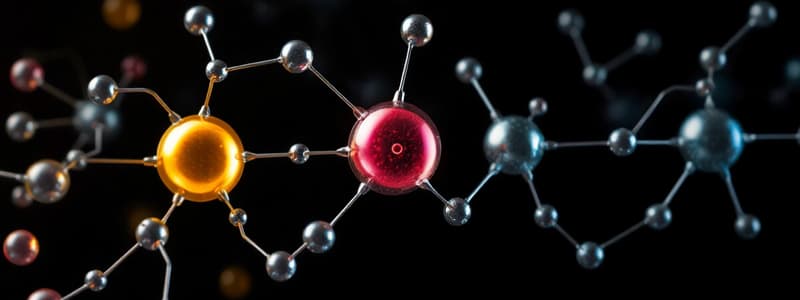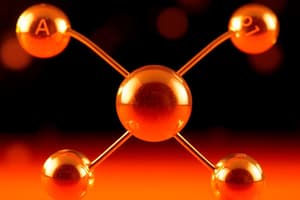Podcast
Questions and Answers
What defines isotopes of the same element?
What defines isotopes of the same element?
- They have different numbers of neutrons. (correct)
- They have the same mass number.
- They have the same atomic number.
- They have different numbers of protons.
Which nitrogen isotope has a mass number of 14?
Which nitrogen isotope has a mass number of 14?
- 15N
- 14N (correct)
- 16N
- 12N
How many valence electrons does oxygen have?
How many valence electrons does oxygen have?
- 4
- 8
- 6 (correct)
- 5
What is the outermost shell of an atom called?
What is the outermost shell of an atom called?
What is the tendency of an atom to achieve a configuration of eight electrons in its valence shell called?
What is the tendency of an atom to achieve a configuration of eight electrons in its valence shell called?
What type of chemical bond is formed by the transfer of electrons?
What type of chemical bond is formed by the transfer of electrons?
How many valence electrons does silicon have?
How many valence electrons does silicon have?
What happens to atoms when they form ions?
What happens to atoms when they form ions?
What do resonance structures represent?
What do resonance structures represent?
How do resonance structures differ from structures that involve equilibrium?
How do resonance structures differ from structures that involve equilibrium?
What is the primary use of resonance structures?
What is the primary use of resonance structures?
Which statement about resonance structures is correct?
Which statement about resonance structures is correct?
How are resonance structures created?
How are resonance structures created?
What type of bond is present in ethyne (acetylene)?
What type of bond is present in ethyne (acetylene)?
In Lewis structures, what do we add for a negative ion?
In Lewis structures, what do we add for a negative ion?
Which compound is an example of a covalent bond?
Which compound is an example of a covalent bond?
Which of the following correctly reflects the octet rule in Lewis structures?
Which of the following correctly reflects the octet rule in Lewis structures?
How many valence electrons does a neutral atom contribute to a Lewis structure if it is in Group 5 of the periodic table?
How many valence electrons does a neutral atom contribute to a Lewis structure if it is in Group 5 of the periodic table?
What is one reason to use multiple bonds in Lewis structures?
What is one reason to use multiple bonds in Lewis structures?
Which of the following is a correct Lewis structure example?
Which of the following is a correct Lewis structure example?
What should you do when drawing the Lewis structure for a positive ion?
What should you do when drawing the Lewis structure for a positive ion?
What does a Lewis structure represent in a molecule?
What does a Lewis structure represent in a molecule?
Which of the following illustrates resonance structures?
Which of the following illustrates resonance structures?
What are resonance contributors also known as?
What are resonance contributors also known as?
In resonance theory, how are equivalent structures characterized?
In resonance theory, how are equivalent structures characterized?
How many equivalent structures can represent some molecules or ions according to resonance theory?
How many equivalent structures can represent some molecules or ions according to resonance theory?
Which statement is true regarding resonance structures?
Which statement is true regarding resonance structures?
What do all equivalent resonance structures depict about bond lengths?
What do all equivalent resonance structures depict about bond lengths?
Which geometry is represented by the example of bromomethane?
Which geometry is represented by the example of bromomethane?
What hybridization is depicted in the structure of methane?
What hybridization is depicted in the structure of methane?
What is the bond angle in a tetrahedral structure like that of methane?
What is the bond angle in a tetrahedral structure like that of methane?
What type of bond is formed by sp2 hybridized carbons?
What type of bond is formed by sp2 hybridized carbons?
What is the energy barrier to rotation associated with a double bond?
What is the energy barrier to rotation associated with a double bond?
Which statement best describes cis-trans isomerism?
Which statement best describes cis-trans isomerism?
What type of structure does an sp2 hybridization result in?
What type of structure does an sp2 hybridization result in?
How many sigma bonds are formed by an sp3 hybridized carbon?
How many sigma bonds are formed by an sp3 hybridized carbon?
What type of orbitals overlap to form a pi bond?
What type of orbitals overlap to form a pi bond?
The strength of a C-C single bond is typically associated with which energy range?
The strength of a C-C single bond is typically associated with which energy range?
Which of the following best describes a structure with cis configuration?
Which of the following best describes a structure with cis configuration?
Study Notes
Isotopes
- Isotopes are atoms of the same element that have the same number of protons but different numbers of neutrons.
- The number of protons determines the atomic number of an element.
- The number of protons and neutrons together determine the mass number of an atom.
- Carbon has an atomic number of 6, meaning it has 6 protons in its nucleus.
- Most carbon atoms also have 6 neutrons, giving them a mass number of 12, written as ¹²C.
Valence Electrons
- The valence shell is the outermost shell of an atom.
- Valence electrons are the electrons in the valence shell that an atom uses to form chemical bonds.
- The number of valence electrons an atom has is equal to its group number on the periodic table.
- For example, carbon (group IVA) has four valence electrons, while oxygen (group VIA) has six.
Chemical Bonds: The Octet Rule
- Ionic bonds are formed by the transfer of electrons between atoms.
- Covalent bonds are formed by the sharing of electrons between atoms.
- The octet rule states that atoms tend to achieve a configuration where their valence shell contains eight electrons.
- This rule is a way to predict how atoms will bond together to form molecules.
Lewis Structures
- Lewis structures are diagrams that show the connections between atoms in a molecule using only the valence electrons.
- Main group elements have the same number of valence electrons as their group number.
- If a structure is an anion, add one electron for each negative charge.
- If a structure is a cation, subtract one electron for each positive charge.
- When drawing Lewis structures, aim to give each atom the electron configuration of a noble gas, which typically has eight valence electrons.
Resonance Theory
- Resonance theory is used to describe molecules or ions where a single Lewis structure is inadequate.
- Two or more equivalent resonance structures can be drawn to represent the same molecule.
- The real molecule or ion is a hybrid of all the resonance structures.
- Resonance structures are not real structures but are used to better represent the molecule or ion.
Hybridization: sp³ Hybridization
- Hybridization is the mixing of atomic orbitals to form new hybrid orbitals with different shapes and energies.
- sp³ hybridization occurs when one s orbital and three p orbitals combine to form four sp³ orbitals.
- Each sp³ orbital has a tetrahedral shape.
- Methane (CH₄) is an example of a molecule with sp³ hybridized carbon.
Hybridization: sp² Hybridization
- sp² hybridization occurs when one s orbital and two p orbitals combine to form three sp² orbitals.
- These sp² orbitals are planar and have a trigonal planar shape.
- Ethene (C₂H₄) is an example of a molecule with sp² hybridized carbons.
- The sp² hybridized carbons in ethene form a double bond consisting of a sigma bond and a pi bond.
Restricted Rotation and the Double Bond
- Restricted rotation exists about a double bond due to the strength of the pi bond.
- Rotation around the double bond breaks the pi bond and requires significant energy.
Cis-Trans Isomerism
- Cis-trans isomerism arises due to restricted rotation around a double bond.
- Cis isomers have the same substituents on the same side of the double bond.
- Trans isomers have the same substituents on opposite sides of the double bond.
- Cis-trans isomerism is only possible for disubstituted alkenes, which have two different substituents on each carbon of the double bond.
Studying That Suits You
Use AI to generate personalized quizzes and flashcards to suit your learning preferences.
Related Documents
Description
This quiz covers fundamental concepts of isotopes, valence electrons, and chemical bonds, including the octet rule. You will explore how protons and neutrons define atomic structure, and the significance of valence electrons in bond formation. Test your understanding of these essential chemistry topics!




